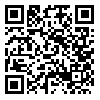Volume 1402, Issue 3 (10-2023)
2023, 1402(3): 0-0 |
Back to browse issues page
Ethics code: IR.MEDILAM.REC.1400.003
Download citation:
BibTeX | RIS | EndNote | Medlars | ProCite | Reference Manager | RefWorks
Send citation to:



BibTeX | RIS | EndNote | Medlars | ProCite | Reference Manager | RefWorks
Send citation to:
Sadeghifard N, hashemian M, Nazari A, Kazemian H. Prevalence of nosocomial infections in ICU 1 and 2 wards of Imam Khomeini Hospital in Ilam, Iran. Journal title 2023; 1402 (3)
URL: http://newresearch.medilam.ac.ir/article-1-1145-en.html
URL: http://newresearch.medilam.ac.ir/article-1-1145-en.html
Clinical Microbiology Research Center, Ilam University of Medical sciences, Ilam, Iran
Abstract: (1114 Views)
Nosocomial infections can usually occur 48 to 72 hours after admission, or even a week after discharge (1-3). Today, these infections are considered as the main problems in modern medicine in the world and in Iran (4, 5). One of the most important causes of nosocomial infections is the Enterobacteriaceae family, which is of special importance due to the production of broad-spectrum beta-lactamases (ESBLs and carbapenemases) (6-8). Today, special measures have been taken to control nosocomial infections, however, due to the variety of infectious agents, the administration of broad-spectrum antibiotics, the use of immunosuppressive drugs and poor hygiene in hospitals, the incidence of these infections continues to increase. It causes problems in the treatment process of hospitalized patients. In Iran, bacterial infections are not well controlled, in Ilam province, the mortality rate due to nosocomial infections is not determined, and on the other hand, due to the lack of routine laboratory methods to correctly determine bacteria, lack of knowledge of standards can make a correct diagnosis. Bacteria were not the cause of infection and the level of bacterial resistance. The sum of these factors shows the importance of investigating the prevalence of infections and determining drug resistance. By identifying the predominant causative agent of infection and rapid detection of bacteria producing ESBLs and carbapenemase He established this factor as an important factor in the hospital. Finally, by controlling the infection and resistance, he prevented the further spread of resistance (1, 9, 10). Nosocomial infections are usually 48 to 72 hours after the patientchr('39')s hospitalization, or even a They can occur weeks after discharge (1-3). Today, these infections are considered as the main problems in modern medicine in the world and in Iran (4, 5). One of the most important causes of nosocomial infections is the Enterobacteriaceae family, which is of special importance due to the production of broad-spectrum beta-lactamases (ESBLs) and carbapenemase (6-8). Today, special measures have been taken to control nosocomial infections, however, due to the variety of infectious agents, the administration of broad-spectrum antibiotics, the use of immunosuppressive drugs and poor hygiene in hospitals, the incidence of these infections continues to increase. It causes problems in the treatment process of hospitalized patients. In Iran, bacterial infections are not well controlled, in Ilam province, the mortality rate due to nosocomial infections is not determined, and on the other hand, due to the lack of routine laboratory methods to correctly determine bacteria, lack of knowledge of standards can make a correct diagnosis. Bacteria were not the cause of infection and the level of bacterial resistance. The sum of these factors shows the importance of investigating the prevalence of infections and determining drug resistance. By identifying the predominant causative agent of infection and rapid detection of bacteria producing ESBLs and carbapenemase He established this factor as an important thing in the hospital and finally prevented the further spread of resistance by controlling infection and resistance (1, 9, 10).
: Cross sectional |
Received: 2020/08/5 | Accepted: 2020/12/13 | Published: 2023/10/2
Received: 2020/08/5 | Accepted: 2020/12/13 | Published: 2023/10/2
Send email to the proposal executer
| Rights and permissions | |
 | This work is licensed under a Creative Commons Attribution-NonCommercial 4.0 International License. |






